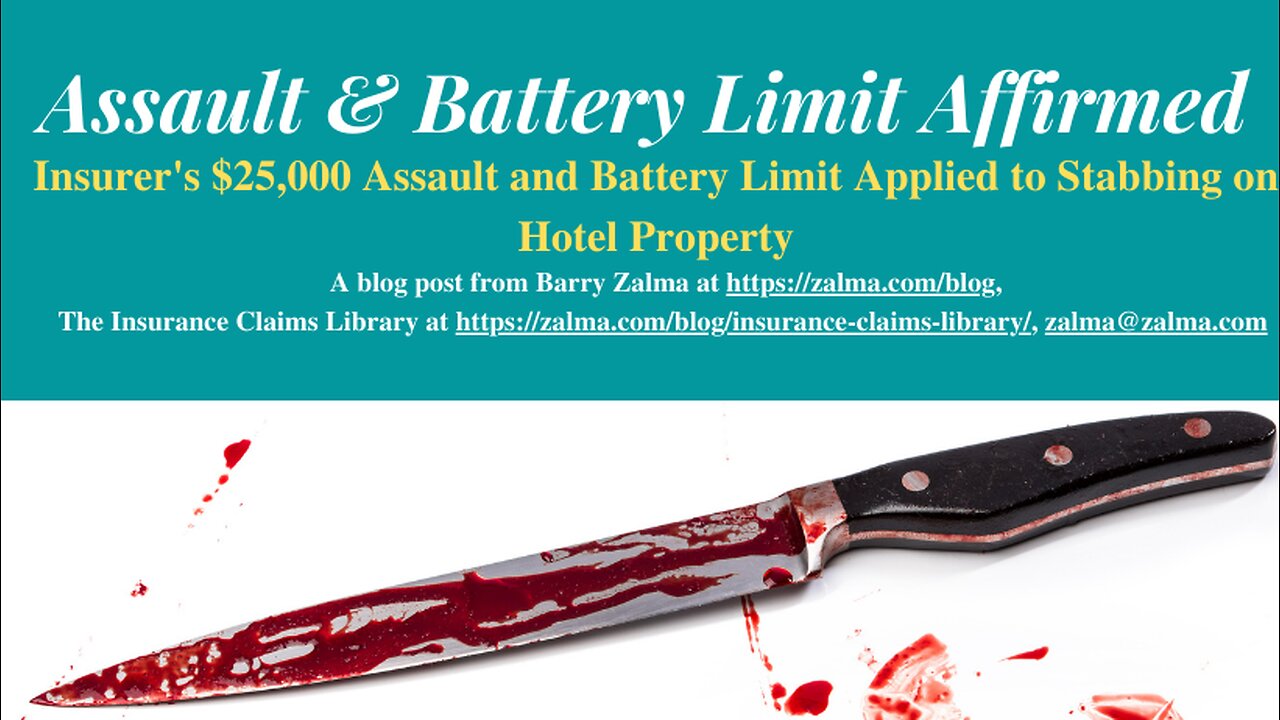Premium Only Content

Assault & Battery Limit Affirmed
Insurer's $25,000 Assault and Battery Limit Applied to Stabbing on Hotel Property
Great American E & S Insurance Company obtained a trial court judgment that it is only obligated to provide coverage up to a limit of $25,000 under a policy of insurance issued to the defendant Commack Hotel, LLC, doing business as Howard Johnson, in an underlying action where Stanley Earl Davis, Jr. was stabbed to death at the hotel property.
In Great American E & S Insurance Company v. Commack Hotel, LLC, etc., et al., Stanley Davis, etc., No. 2019-13798, Index No. 615088/16, 2022 NY Slip Op 06915, Supreme Court of New York, Second Department (December 7, 2022) the appellate court resolved the dispute.
Stanley Davis appealed from an order of the Supreme Court, Suffolk County (David T. Reilly, J.), dated October 21, 2019. The order granted the plaintiff's motion for summary judgment on the complaint and the plaintiff appealed
FACTS
On November 13, 2010, the defendant Stanley Davis's son (hereinafter the decedent) was stabbed to death by the defendant Carlos Rodriguez during a party in a room at a hotel owned by the defendant Commack Hotel, LLC, doing business as Howard Johnson (hereinafter Howard Johnson).
In an underlying action entitled Davis v Commack Hotel, LLC, the defendant Stanley Davis, as administrator of the decedent's estate, was awarded summary judgment on the issue of liability against, among others, Howard Johnson, the plaintiff's insured.
Following that determination, the plaintiff commenced this action for a judgment declaring that it owes no obligation to indemnify Howard Johnson in excess of $25,000 under the assault and battery limits of liability endorsement of its insurance policy and moved for summary judgment on the complaint.
In an order dated October 21, 2019, the Supreme Court granted the plaintiff's motion, finding that the plaintiff's obligation to pay damages on behalf of Howard Johnson in connection with the underlying action was limited to the assault and battery sublimit set forth in the endorsement.
DUTY TO DEFEND
The duty to defend is triggered whenever the allegations of a complaint, liberally construed, suggest a reasonable possibility of coverage, or the insurer has actual knowledge of facts establishing a reasonable possibility of coverage. An insurance carrier can be relieved of its duty to defend if it establishes, as a matter of law, that there is no possible factual or legal basis on which it might eventually be obligated to indemnify its insured under any policy provision. Policy exclusions are subject to strict construction and must be read narrowly, and any ambiguities in the insurance policy are to be construed against the insurer. However, unambiguous provisions of insurance contracts will be given their plain and ordinary meaning.
An exclusion for assault and/or battery applies if no cause of action would exist but for the assault and/or battery. The appellate court determined that negligence claims arising from an assault and battery also fall under assault and battery endorsements that limit coverage for damages.
Here, the plaintiff established its prima facie entitlement to judgment as a matter of law by demonstrating that the assault and battery endorsement's limitation is applicable to the claims asserted against Howard Johnson by Davis in the underlying action.
Accordingly, the trial court, the Supreme Court, properly granted the plaintiff's motion for summary judgment on the complaint, which sought a judgment declaring that the plaintiff is only obligated to provide insurance coverage up to a limit of $25,000 under the policy in the underlying action.
ZALMA OPINION
Most insurers of public properties will exclude defense or indemnity for an assault or battery. Some, attempting to provide better coverage will insure against claims of assault and/or battery but limit the amount the insurer is willing to pay to indemnify its insured. Commack Hotel, LLC, doing business as Howard Johnson obtained a policy with a $25,000 limit. The appellate court agreed that the limitation was appropriate and enforceable.
(c) 2022 Barry Zalma & ClaimSchool, Inc.
Subscribe and receive videos limited to subscribers of Excellence in Claims Handling at locals.com https://zalmaoninsurance.locals.com/subscribe.
Go to substack at substack.com/refer/barryzalma Consider subscribing to my publications at substack at substack.com/refer/barryzalma
Barry Zalma, Esq., CFE, now limits his practice to service as an insurance consultant specializing in insurance coverage, insurance claims handling, insurance bad faith and insurance fraud almost equally for insurers and policyholders. He practiced law in California for more than 44 years as an insurance coverage and claims handling lawyer and more than 54 years in the insurance business. He is available at http://www.zalma.com and zalma@zalma.com
Write to Mr. Zalma at zalma@zalma.com; http://www.zalma.com; http://zalma.com/blog; daily articles are published at https://zalma.substack.com.
Write to Mr. Zalma at zalma@zalma.com; http://www.zalma.com; http://zalma.com/blog; daily articles are published at https://zalma.substack.com. Go to the podcast Zalma On Insurance at https://anchor.fm/barry-zalma; Follow Mr. Zalma on Twitter at https://twitter.com/bzalma; Go to Barry Zalma videos at Rumble.com at https://rumble.com/c/c-262921; Go to Barry Zalma on YouTube- https://www.youtube.com/channel/UCysiZklEtxZsSF9DfC0Expg; Go to the Insurance Claims Library – https://zalma.com/blog/insurance-claims-library.
-
 8:36
8:36
Barry Zalma, Inc. on Insurance Law
1 year agoZalma's Insurance Fraud Letter - January 15, 2024
287 -
 8:19
8:19
MattMorseTV
8 hours ago $2.90 earnedTrump is ACTUALLY DOING IT.
13.6K29 -
 LIVE
LIVE
ZWOGs
11 hours ago🔴LIVE IN 1440p! - Tarkov w/ Casey & crgoodw1n, Kingdom Come Deliverance, & More - Come Hang Out!
141 watching -
 LIVE
LIVE
We Like Shooting
14 hours agoWe Like Shooting 625 (Gun Podcast)
160 watching -
 1:45:02
1:45:02
Glenn Greenwald
5 hours agoIsrael Slaughters More Journalists, Hiding War Crimes; Trump's Unconstitutional Flag Burning Ban; Glenn Takes Your Questions | SYSTEM UPDATE #504
100K118 -
 1:29:31
1:29:31
Killerperk
2 hours ago $0.35 earnedRoad to BF6. Come hang out #regiment #bf6
11.2K1 -
 LIVE
LIVE
Jokeuhl Gaming and Chat
3 hours agoDARKTIDE - Warhammer 40k w/ Nubes Bloobs and AoA
32 watching -
 LIVE
LIVE
Cripiechuccles
4 hours ago😁💚💙MOTA MONDAY WITH CRIPIE💚💙 👌SMOKING, GAMING & WATCHING FLICKS!:😁
38 watching -
 36:11
36:11
Stephen Gardner
3 hours ago🔥'Burn ALL TRUMP FLAGS’ says Tim Walz + Democrat CAUGHT rigging own election!
16.2K12 -
 10:10
10:10
robbijan
1 day agoHollywood’s Hidden Messages: Predictive Programming & What’s Next
13.5K15